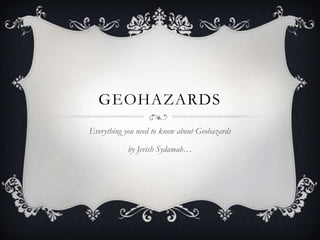
Geohazards
- 1. GEOHAZARDS Everything you need to know about Geohazards by Jevish Sydamah…
- 2. WHAT IS GEOHAZARDS? A Geohazard is any natural hazard that is caused by the Earth, for example volcanoes, earthquakes, floods, tsunamis and cyclones. These and other Geohazards can cause great loss of life and damage to property when they occur so governments are always looking for ways of reducing the impacts of Geohazards. It is sometimes possible to predict when certain Geohazards will occur, such as volcanoes and cyclones. For example the eruption of a volcano can be predicted when scientists observe the following warning signs: 1. The gases that volcanoes give off suddenly change. 2. Small earthquakes happen in the local area. 3. The volcano starts to get bigger as it fills with magma.
- 3. EARTHQUAKES Earthquakes: Fractures in Earth's crust, or lithosphere (its crust and upper mantle), where sections of rock have slipped past each other are called faults. Earthquakes are caused by the sudden release of accumulated strain along these faults, releasing energy in the form of low-frequency sound waves called seismic waves. A major earthquake are usually followed by aftershocks. The epicentres of large earthquakes are normally located along known seismically active zones, although the disruptive effects of an earthquake may extend over areas 100s of kilometres away. Earthquakes may cause liquefaction, landslides, marine landslides and tsunamis.
- 4. VOLCANOES Volcanoes: A volcano is defined by an opening in the Earth's crust from which lava, ash, and hot gases flow or are ejected during an eruption. Volcanic hazards vary from one volcano to another and from one eruption to the next. The big killers are pyroclastic flows, lahars, and tsunamis triggered by volcanic eruptions. The most frequent lethal events are so-called tephra explosions – very rapid jets of lava . The longest- lasting damage is usually inflicted by thick lava flows or major collapses of volcanic edifices, as at Mt. St. Helens in 1980.
- 5. LANDSLIDES Landslides: A landslide is a Geohazard that involves the breakup and downhill flow of rock, mud, water and anything caught in the path. Landslides are one of the main processes by which landscapes evolve and the related hazards result in a complex, changing landscape. Landslides both vary enormously in their distribution in space and time, the amounts of energy produced during the activity and especially in size. This means that the resulting surface deformation or displacement varies considerably from one type of instability (that trigger the breakup) to another. Individual ground instabilities may have a common trigger, such as an extreme rainfall event or an earthquake, and therefore occur alongside many equivalent occurrences over a large area. This means that they can have a significant regional impact.
- 6. TSUNAMIS Tsunamis: Tsunamis are gravity waves (different physical features than wind induced surface waves) created by a rapid displacement of a water column. The displacement can be the result of earthquakes, volcanic eruptions or landslides. These energetic waves travel fast with long wavelengths and relatively small amplitudes in open ocean. When hitting shallow water they build up an amplitude and can become tens, and on very rare occasions, even hundreds of meters high. The coastal inundation can be devastating and catastrophic.
- 7. EXTREME GEOHAZARDS Extreme Geohazards The Sumatran earthquake/Indian ocean tsunami was one of the most extreme Geohazard in modern history . This extreme reached us all, beyond the mere geophysical waves. As tourists come from all over the world to visit the beautiful shores of the Indian ocean, the 2004 tsunami affected people from around the globe. The extent of it's destruction and the dimension of the disaster are parts of the definition of extreme. That, combined with their physical features that normally are several orders higher or more powerful than the average Geohazard. So, when we talk about extreme Geohazards we not only refer to the physical characteristics of the Geohazard but also the risk they represent in terms of consequences of this hazard.
- 8. MEGA TSUNAMIS AND SUPER VOLCANOES Really extreme Geohazards – mega tsunamis and super volcanoes Norway is situated in a safe distance from the Ring of Fire. Crustal movements in this part of the world are very slow stemming from post glacial rebound, the uplift of ground due to the absence of heavy glaciers that melted thousands of years ago. Norway has in fact a rather high number of earthquakes as well but these far from qualify as extreme Geohazards. But, if we look at the geological history of Norway we find evidence of a really extreme Geohazard. More than 8000 years ago, the submarine Storegga landslide caused a wide ranging mega tsunami hitting most of our entire coastline.
- 9. EXAMPLE OF A GEOHAZARD Submarine) Landslides Debris flows Shallow gas accumulation Overpressured zones (including gas and shallow water flows) Naturally occurring gas hydrates and their climate-controlled meta-stability Mud flows, diapirism and mud volcanism/mud volcanoes Earthquakes and seismicity Tsunamis from tectonics and landslides Rock falls and landslides
- 10. STATS CAUSED BY GEOHAZARDS The World Disasters Report 2005 estimated that in 2004, over 250,000 were reported killed by natural disasters—mostly from the Indian Ocean tsunami in December. Disasters affected 146 million persons and inflicted estimated damage of US$ 100-145 billion. From 1995 to 2004, about 6,000 reported disasters killed over 900,000, affected over 2.5 billion persons, and caused at least US$ 738 billion in estimated damage . This compares to 640,000 reported killed and 1.74 billion reported affected by natural disasters from 1985 to 1994. Over the decade, 51 people died per natural disaster event in countries of high human development (as defined by United Nations Development Program), compared to 573 deaths per event in countries of low human development.
- 11. PHOTOS…
- 12. STRUCTURE…
- 14. VOLCANO…
- 15. LANDSLIDE…
- 16. TSUNAMI…
- 17. EARTHQUAKE…
- 18. HOPE YOU ENJOYED THE PRESENTATION. THANK YOU FOR READING… BY JEVISH SYDAMAH